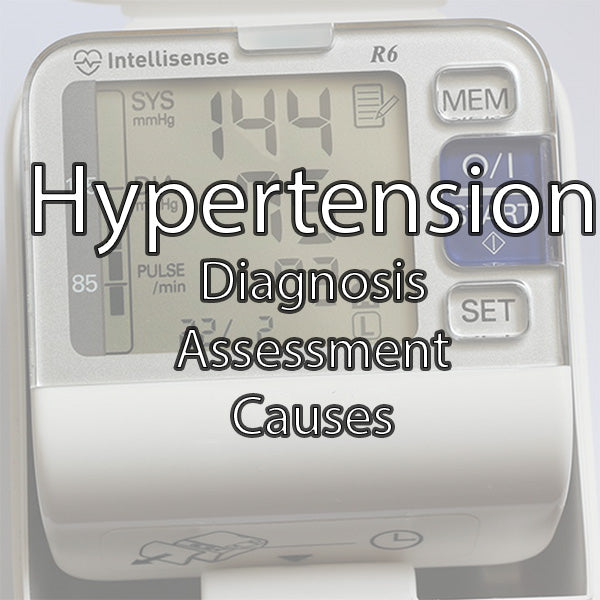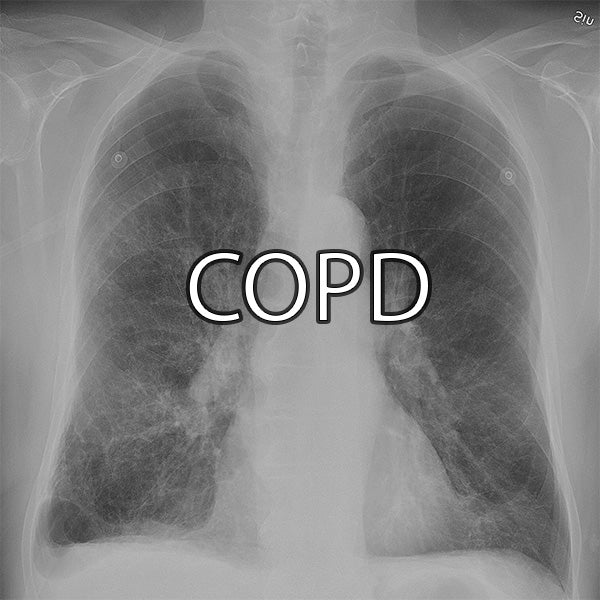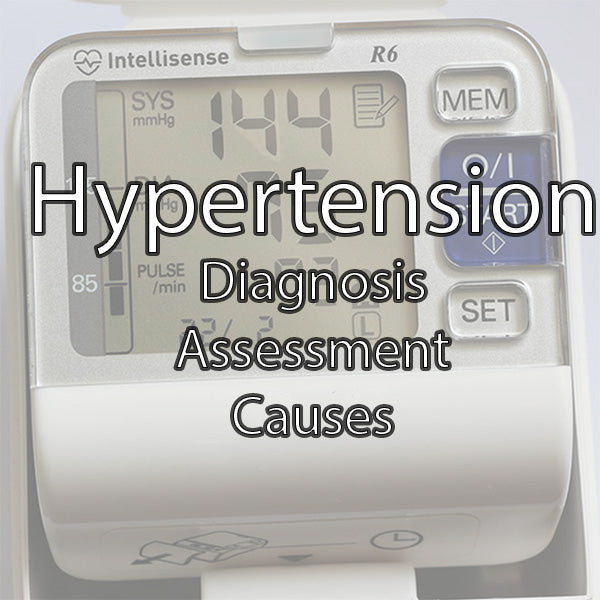Hypertension - Definition & Diagnosis, Causes, Primary vs Secondary Hypertension (Webinar)

By YardCard Team
What is Hypertension?
Hypertension is persistently raised arterial blood pressure. It can also be defined as the level of blood pressure above which treatment does more good than harm, so thresholds vary.
Hypertension in adults is generally suspected if there is a blood pressure of >140/>90 mmHg. This should prompt you to confirm the diagnosis with either home blood pressure monitoring (HBPM) or ambulatory BP monitoring (ABPM), to investigate for target organ damage, and to assess cardiovascular risk.
It is a major cause of premature death worldwide, with upwards of 1 in 4 men and 1 in 5 women affected. The burden of hypertension is felt disproportionately in low- and middle-income communities.
Hypertension is usually asymptomatic until late in course.
Persistently elevated blood pressure over time typically results in damage to blood vessels, especially smaller muscular arteries and arterioles. Organ damage can be caused, and complications include stroke, heart attacks, heart failure, aortic aneurysms, kidney disease, vascular dementia and peripheral artery disease.
Hypertension is classified according to severity (from NICE CKS):
Stage 1 hypertension — clinic blood pressure ranging from 140/90 mmHg to 159/99 mmHg and subsequent ABPM daytime average or HBPM average blood pressure ranging from 135/85 mmHg to 149/94 mmHg.
Stage 2 hypertension — clinic blood pressure of 160/100 mmHg or higher but less than 180/120 mmHg and subsequent ABPM daytime average or HBPM average blood pressure of 150/95 mmHg or higher.
Stage 3 or severe hypertension — clinic systolic blood pressure of 180 mmHg or higher or clinic diastolic blood pressure of 120 mmHg or higher.
| Age Group | Clinic BP Target | ABPM/HBPM Target |
|---|---|---|
| Under 80 years | Below 140/90 mmHg | Below 135/85 mmHg |
| 80 years and older* | Below 150/90 mmHg | Below 145/85 mmHg |
| Postural hypertension | Based on standing blood pressure | |
| Frailty or multimorbidity | Use clinical judgement |
*Evidence-based guideline - target of 150/80mmHg ≥ 80 associated with lower mortality after adjustment for baseline frailty in the HYpertension in the Very Elderly Trial (HYVET)
It’s also important to know when to refer patients for same day assessment in Stage 3 hypertension. Essentially, this is when end-organ damage (or phaeochromocytoma) is suspected and it is a common presentation to A&E. NICE states you should refer for same day assessment if:
- A clinic blood pressure of 180/120 mmHg and higher with signs of retinal haemorrhage or papilloedema (accelerated hypertension) or life-threatening symptoms, such as new onset confusion, chest pain, signs of heart failure, or acute kidney injury.
- Suspected phaeochromocytoma, for example labile or postural hypotension, headache, palpitations, pallor, abdominal pain, or diaphoresis.
It can also be classed as primary or secondary. Primary ('essential') hypertension is the most common type (90% in adults), and is often idiopathic with unknown pathogenesis. Secondary hypertension is less common (5-15% in adults) and occurs as a result of other identifiable pathologies.
White-coat hypertension is blood pressure that is raised in the clinical setting but not in other settings.
Lay explanation - how would you explain hypertension to a patient?
“High blood pressure rarely has any noticeable symptoms, but if left untreated it increases your risk of serious problems such as heart attacks and strokes. If you have high blood pressure, even reducing it a small amount can reduce your risk of these conditions. Blood pressure is recorded with two numbers, the higher number (systolic pressure) is the force at which your heart pumps blood around your body. The lower number (diastolic) is the resistance to blood flow in the blood vessels.”
Primary vs Secondary Hypertension
Primary ('essential') hypertension is the most common type (90% in adults), and is often idiopathic with unknown pathogenesis.
Secondary hypertension is less common (5-10% in adults) and occurs as a result of other identifiable pathologies.
Let’s look at the risk factors for primary hypertension first, then explore the causes of secondary hypertension.
Risk Factors for Primary Hypertension
Primary ('essential') hypertension: Most common (90% in adults), often idiopathic but has both modifiable and non-modifiable risk factors
Modifiable Risk Factors
- Obesity
- Excess sodium intake
- Lack of exercise
- Stress
- Smoking
- Diabetes mellitus
- Moderate to high alcohol intake
Non-modifiable Risk Factors
- Older age
- Family history
- Ethnicity (African, Caribbean or South Asian)
- Male (if <65 years)
- Female (if >65 years)
- Genetic factors
Social deprivation — people from the most deprived areas in England are 30% more likely to have hypertension than those from the least deprived.
How is hypertension diagnosed?
Measure BP in both arms during consultation (repeat if >15 mmHg difference)
If BP ≥140/90, take a second measurement and record the lower as clinic BP
Confirm diagnosis with ambulatory or home BP monitoring
Investigate for target organ damage once diagnosis is confirmed
You can use a home BP diary and ask the patient to get a BP cuff from the local pharmacy. An example printable BP diary is:
https://bihsoc.org/wp-content/uploads/2017/09/Home_blood_pressure_diary.pdf.
What are the causes of secondary hypertension?
Secondary hypertension should be considered in the presence of suggestive symptoms and signs:
- severe or drug-resistant hypertension
- age of onset younger than 40 years (especially before puberty)
- hypertensive emergency
- sudden deterioration in BP control - acute rise in blood pressure from previously stable readings.
Clinical clues
- Muscle weakness/tetany, cramps, or arrhythmias (Primary hyperaldosteronism)
- Rapid onset acute pulmonary oedema (renal artery stenosis)
- Sweating, palpitations, or frequent headaches (phaeochromocytoma/paraganglioma)
- Snoring or daytime sleepiness (obstructive sleep apnoea)
These patients should be throughly investigated for secondary hypertension.
Renal disorders such as CKD, diabetic nephropathy or polycystic kidney disease are the most common cause of secondary hypertension.
Other causes include renal artery stenosis, medications, obstructive sleep apnoea, pregnancy and endocrine disorders.
- Renal disease (parenchymal or vascular)
- Renal artery stenosis - relatively common, can cause hypertension, renal failure and oedema, avoid ACEis, can treat with angioplasty
- Endocrine disorders e.g.
- hyperthyroidism
- Cushing's syndrome
- hyperaldosteronism - Conn's syndrome (aldosterone:renin ratio is helpful is HTN can be only sign)
- Cardiovascular disorders (e.g., coarctation of the aorta in which you would see reduced blood flow to the right arm)
- Obstructive sleep apnoea
- Pregnancy-related (pre-eclampsia)
- Pharmacological causes (e.g., alcohol, cyclosporin, COCP (NB: hypertension is a contra-indication to COCP)
- Fibromuscular dysplasia (think of this rare condition in hypertensive women 20-50 years - it causes stenosis or aneuryms in arteries such as the carotid and renal arteries)








Leave a comment